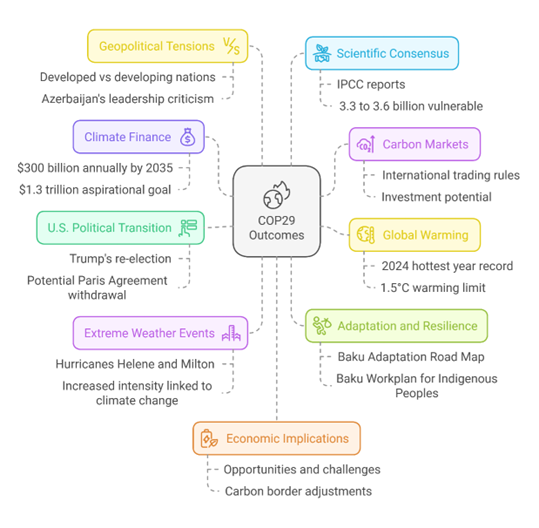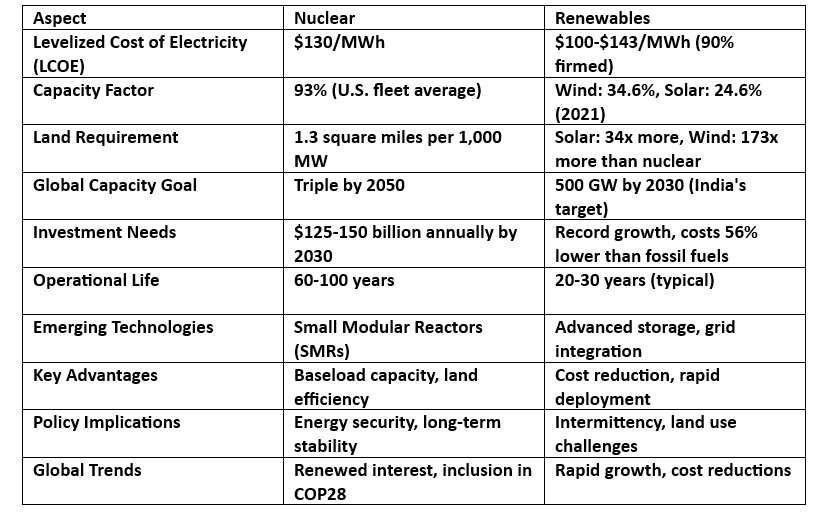THE CONTEXT: COP29, held in Baku, Azerbaijan, in 2024, focused on climate finance and carbon markets. The conference agreed on a new climate finance goal of $300 billion annually by 2035 and finalized rules for international carbon trading under Article 6 of the Paris Agreement but made limited progress on fossil fuel phaseout and mitigation efforts.

FACTORS ACCELERATING ENERGY TRANSITION:
-
- EU’s Carbon Border Adjustment Mechanism (CBAM): Potential contraction of EU imports of CBAM goods by 4-26% by 2030. Encouraging other countries to implement carbon pricing systems or similar mechanisms. Developing countries may face challenges due to more carbon-intensive industries and limited fiscal capacity for decarbonization.
- Pressure to Accept ‘Peaking’ of Emissions: This is the point at which a country’s greenhouse gas emissions reach their maximum before beginning to decline. It is essential for achieving the Paris Agreement goal of limiting global warming to 1.5°C above pre-industrial levels.
- G7 Summit Calls for Major Economies to Peak Emissions by 2025: Compared to 2019, aim to cut emissions by 43% by 2030 and 60% by 2035. Developing countries need enhanced international cooperation and support in their decarbonization efforts.
INDIA’S UNIQUE CHALLENGES:
-
- Development Imperatives vs. Climate Action: India aims to become a $5 trillion economy by 2025-26, requiring sustained GDP growth of 8-9% annually. Climate change could push 50 million people back into poverty by 2100, necessitating robust economic policies. Over 75% of Indian districts are classified as hotspots for extreme climate events, with potential annual GDP losses of 2.5-4.5% by 2030.
- Electricity Consumption: The industrial sector consumes 41.16% of total electricity, crucial for manufacturing and economic expansion. Rapid urbanization drives increased energy demand, particularly in residential (25.77%) and commercial (8.29%) sectors. Space cooling will account for 45% of India’s peak electricity demand by 2050, driven by rising temperatures and improved living standards.
- Twin Challenges of Growth and Diversification: Balancing intermittent renewable sources with baseload power requires significant investments in grid infrastructure and storage technologies. India faces a financing gap of $2.5 trillion to meet its Nationally Determined Contribution (NDC) commitments by 2030. Developing a robust domestic renewable energy industry is essential for reducing import dependence and creating employment.

CARBON TRADING AND INDIA’S POSITION:
-
- Development Imperatives: India’s per capita emissions are only 1.9 tonnes (2022), compared to the global average of 4.7 tonnes, highlighting its low historical responsibility for climate change. Rapid industrialization and urbanization necessitate increased energy consumption, with electricity demand projected to grow from 1,395 kWh per capita (2024) to over 3,000 kWh by 2040.
- Carbon Space as a Developmental Right: India emphasizes the principle of Common but Differentiated Responsibilities and Respective Capabilities (CBDR-RC) under the UNFCCC framework. It seeks an equitable share of the remaining global carbon budget to ensure sustainable growth while addressing poverty alleviation and energy access.
- Policy Measures: India plans to operationalize its domestic carbon market by 2025-26 under the Bureau of Energy Efficiency (BEE). The Energy Conservation (Amendment) Act, 2022 provides the legal framework for trading carbon credits domestically.
- Strategic Importance of Carbon Markets: Carbon markets enable India to monetize its mitigation efforts while attracting foreign investment in clean technologies. They also support India’s goal of achieving Net Zero by 2070 through cost-effective decarbonization pathways.
THE WAY FORWARD:
-
- Renewable Energy Expansion: India had 203.18 GW of renewable energy capacity and aims to reach 500 GW from non-fossil sources by 2030. Solar power leads with 92.12 GW, followed by wind (47.72 GW) and hydroelectric power (46.93 GW). Initiatives like the National Green Hydrogen Mission and PM-KUSUM are driving renewable energy adoption.
- Nuclear Energy Development: India’s nuclear capacity has doubled in the past decade, reaching 8,180 MW in 2024, and is projected to triple to 22,480 MW by 2031-32. Long-term plans include increasing nuclear capacity to 100 GW by 2047 through indigenous technologies like Pressurized Heavy Water Reactors (PHWRs) and Fast Breeder Reactors (FBRs). Nuclear energy offers reliable baseload power and land-use efficiency, which is critical for India’s energy security.
- Principle of Equity: Operationalizing equity requires recognizing historical emissions and ensuring that developing nations can access carbon space for growth. India must lead coalitions like BASIC (Brazil, South Africa, India, China) and G77+China to demand equitable carbon space allocation. At COP29, India emphasized the need for climate finance, technology transfer, and capacity building to support low-carbon transitions in developing countries.
India accounts for 25% of global energy demand growth over the next two decades. Access to affordable energy is crucial for poverty alleviation, industrial growth, and urbanization. India’s updated NDC targets include reducing emissions intensity by 45% below 2005 levels by 2030 and achieving net zero by 2070.
-
- Balancing Development Needs with Climate Commitments: The Panchamrit framework outlines five key climate pledges, including attaining a non-fossil fuel-based capacity of 50% by 2030, expediting renewable projects through Production-Linked Incentive (PLI) schemes, promoting green hydrogen as a decarbonization tool for industries like refineries and fertilizers, and enhancing public-private partnerships for financing clean energy projects.
THE CONCLUSION:
India must prioritize a balanced energy transition by scaling renewable and nuclear capacities to meet its projected demand of 21,000 TWh by 2070 while advocating for equitable carbon space under the principle of CBDR-RC, ensuring sustainable growth and climate resilience. Achieving this requires leveraging international carbon markets, mobilizing climate finance, and fostering technological innovation to align development imperatives with global climate goals.
UPSC PAST YEAR QUESTION:
Q. Explain the purpose of the Green Grid Initiative launched at the World Leaders Summit of the COP 26 UN Climate Change Conference in Glasgow in November 2021. When was this idea first floated in the International Solar Alliance (ISA)? 2021
MAINS PRACTICE QUESTION:
Q. Discuss the key factors accelerating the energy transition globally, India’s unique challenges in balancing development imperatives with climate commitments, and the role of carbon trading in ensuring equitable access to the global carbon budget.
SOURCE:
Spread the Word
